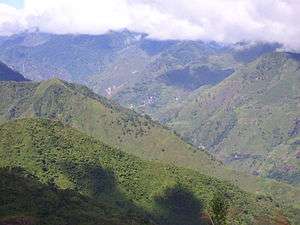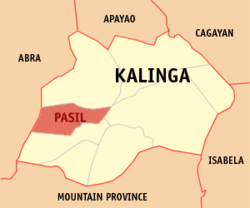Pasil, Kalinga
| Pasil | |
|---|---|
| Municipality | |
| Municipality of Pasil | |
 | |
 Map of Kalinga with Pasil highlighted | |
.svg.png) Pasil Location within the Philippines | |
| Coordinates: 17°23′N 121°09′E / 17.38°N 121.15°ECoordinates: 17°23′N 121°09′E / 17.38°N 121.15°E | |
| Country |
|
| Region | Cordillera Administrative Region (CAR) |
| Province | Kalinga |
| District | Lone District |
| Barangays | 14 (see Barangays) |
| Government [1] | |
| • Type | Sangguniang Bayan |
| • Mayor | James S. Edduba |
| • Electorate | 6,547 voters (2016) |
| Area [2] | |
| • Total | 189.00 km2 (72.97 sq mi) |
| Population (2015 census)[3] | |
| • Total | 9,644 |
| • Density | 51/km2 (130/sq mi) |
| Time zone | UTC+8 (PST) |
| ZIP code | 3803 |
| PSGC | 143208000 |
| IDD : area code | +63 (0)74 |
| Climate type | Tropical rainforest climate |
| Income class | 5th municipal income class |
| Revenue (₱) | 62,181,547.37 (2016) |
| Native languages |
Kalinga language Tagalog |
| Website |
www |
Pasil, officially the Municipality of Pasil is a 5th class municipality in the province of Kalinga, Philippines. According to the 2015 census, it has a population of 9,644 people.[3]
Barangays
Pasil is politically subdivided into 14 barangays.[4]
- Ableg
- Bagtayan
- Balatoc
- Balinciagao Norte
- Balanciagao Sur
- Cagaluan
- Colayo
- Dalupa
- Dangtalan
- Galdang (Casaloan)
- Guina-ang (Poblacion)
- Magsilay
- Malucsad
- Pugong
Demographics
| Population census of Pasil | ||
|---|---|---|
| Year | Pop. | ±% p.a. |
| 1970 | 5,557 | — |
| 1975 | 6,755 | +3.99% |
| 1980 | 6,872 | +0.34% |
| 1990 | 7,572 | +0.97% |
| 1995 | 8,935 | +3.15% |
| 2000 | 9,360 | +1.00% |
| 2007 | 10,084 | +1.03% |
| 2010 | 9,626 | −1.68% |
| 2015 | 9,644 | +0.04% |
| Source: Philippine Statistics Authority[3][5][6][7] | ||
In the 2015 census, the population of Pasil, Kalinga, was 9,644 people,[3] with a density of 51 inhabitants per square kilometre or 130 inhabitants per square mile.
Folkore
In an earlier time, Kabunian–the supreme deity of the Kalinga–left a drop of water upon an ancient tree he passed on one of his travels. This drop trickled down and with a great force akin to magnetism, attracted nearby brooks and rivulets to form what is now called the Pasil River.[8]
References
- ↑ "Municipality". Quezon City, Philippines: Department of the Interior and Local Government. Retrieved 31 May 2013.
- ↑ "Province: Kalinga". PSGC Interactive. Quezon City, Philippines: Philippine Statistics Authority. Retrieved 12 November 2016.
- 1 2 3 4 Census of Population (2015). "Cordillera Administrative Region (CAR)". Total Population by Province, City, Municipality and Barangay. PSA. Retrieved 20 June 2016.
- ↑ "Pasil municipality". Philippine Standard Geographic Code Interactive. Retrieved on 2011-12-20.
- ↑ Census of Population and Housing (2010). "Cordillera Administrative Region (CAR)". Total Population by Province, City, Municipality and Barangay. NSO. Retrieved 29 June 2016.
- ↑ Censuses of Population (1903–2007). "Cordillera Administrative Region (CAR)". Table 1. Population Enumerated in Various Censuses by Province/Highly Urbanized City: 1903 to 2007. NSO.
- ↑ "Province of Kalinga". Municipality Population Data. Local Water Utilities Administration Research Division. Retrieved 17 December 2016.
- ↑ "Pasil Municipal Profile". NERBAC Cordillera Administrative Region. Retrieved on 2011-12-20.
External links
- Pasil LGU Profile on the Local Governance Performance Management System
- Philippine Census Information
This article is issued from
Wikipedia.
The text is licensed under Creative Commons - Attribution - Sharealike.
Additional terms may apply for the media files.